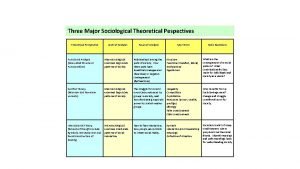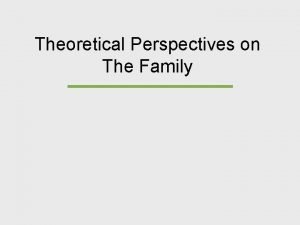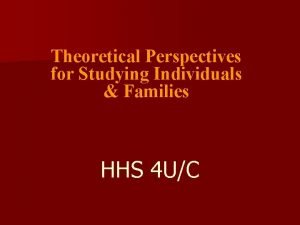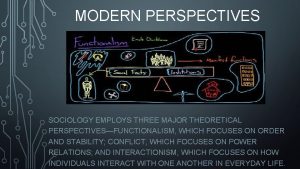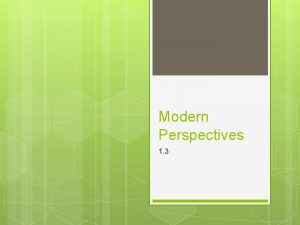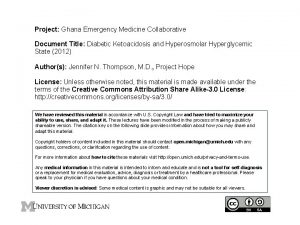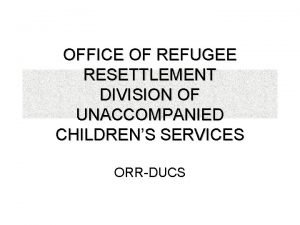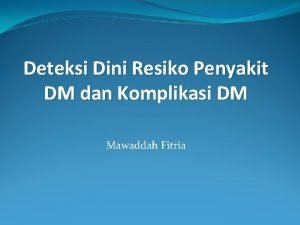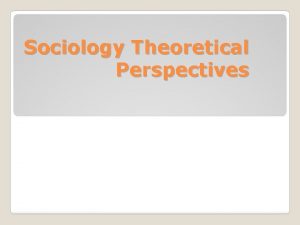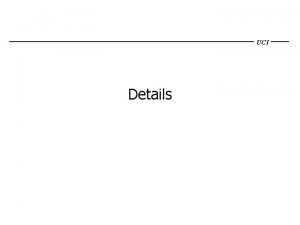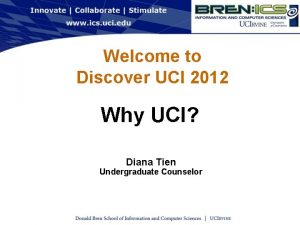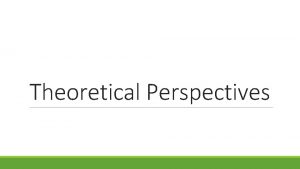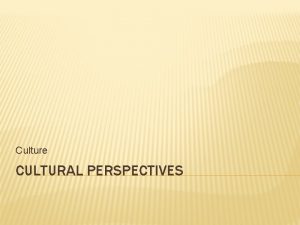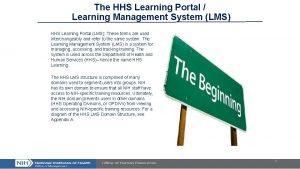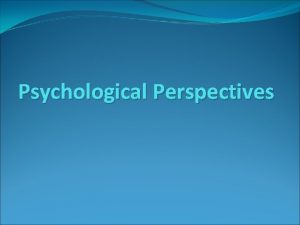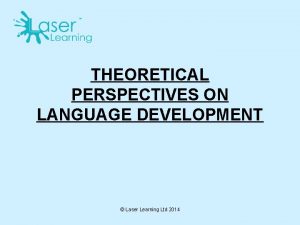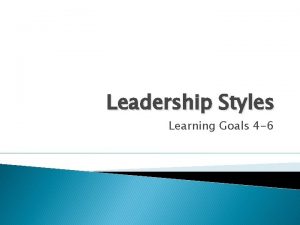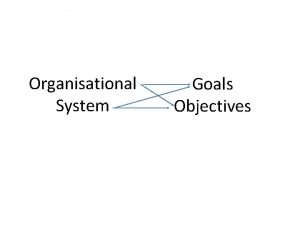Theoretical Perspectives HHS 4 UCI Learning Goals n


























- Slides: 26

Theoretical Perspectives HHS 4 U/CI

Learning Goals n n n By the end of this lesson you will understand seven theoretical perspectives. You will be able to compare theories to each other. You will be able to evaluate the usefulness of each theory.

Success Criteria n On the unit test you will be able to use theories to explain case studies as well as explain why one theory is more useful than another in a particular situation.

Theories n n When scientists explain their observations, their answers reflect their theories Some theories have been used to explain human behaviour for many years Other theories have been revised and replaced Theories are NOT FACTS, just attempts to explain evidence

MICRO vs MACRO Perspectives n n MACRO theories study the interaction between society and institutions such as the law, family, politics, etc. MICRO theories emphasize the relationships within individual families

Theoretical Perspectives n n n n Structural Functionalism Systems Theory Symbolic Interactionism Social Exchange Theory Developmental Theories Conflict Theory Feminist Theory

Structural Functionalism n n MACRO Approach Attempts to explain how society is organized to perform required functions Focuses on how institutions, such as the law, political system, and the family function Assumes societies are stable when structures function to benefit society

Structural Functionalism n Examines the roles individuals play to contribute to the bigger picture n Status = a specific position within a social group n Role = the set of behaviours an individual is expected to demonstrate within a status n Norm = most prevalent behaviours in that role Example: An individual with a “father” status is expected to take on behaviours such as working, child care and providing to fulfill his role. It is the norm for a father to work outside the household.

Structural Functionalism n Strengths of Approach: n n n n Explains how family interacts with society Emphasizes family strengths rather than weaknesses • Weaknesses/Criticisms of Approach: • does not explain why societies or families change. Change and individual differences are seen as disruptions • only one acceptable form of family rather than many variations • doesn’t deal with interpersonal relationships

Systems Theory n n n MICRO AND MACRO Attempts to explain how groups of individuals interact as a system and influence each other A system is a set of interrelated parts Family systems have a complex organization Individuals within the system influence each other in a reciprocal way

Systems Theory n n n The family system changes when a change in one person’s behaviour causes the behaviour of another to evolve The larger family system contains subsystems (father-child, mother-father) A genogram diagram depicts the relationships within a family system

Systems Theory n Advantages: n n n Explains the behaviour of individuals as inseparable from the group Explains why behaviour continues in destructive patterns even through generations Disadvantages: n n n Can be difficult to determine how others within the family are influencing an individuals behaviour Overlooks experience of individuals Social/Structural factors, such as unemployment are not taken into consideration

Symbolic Interactionism n n n MICRO Approach A psychological theory that attempts to explain how individual choose how they will act based on their perceptions of themselves and of others People define and interpret their experiences and give meaning to them

Symbolic Interactionism n n “Me” =objective qualities (tall, male, student) “I” = subjective self (good student, shy, lonely) Role taking = being able to anticipate how other’s will respond Communication requires common language and use of shared symbols

Cooley’s Looking Glass Self n “I am not what I think I am not what you think I am what I think you think I am”

Symbolic Interactionism n Advantages n n Emphasizes mental processes and takes individual perception and interpretations into consideration Sense of individual control Explains importance of shared symbols and communication Disadvantages n n Observations of researchers may be influenced by the researchers interpretations Pays little attention to the impact of wider society and does not explain society-wide changes in families

Social Exchange Theory n n MICRO approach A psychological theory that attempts to explain the social factors that influence reciprocal relationships People act to maximize the benefits and minimize costs to themselves Individuals interpret their experiences in terms of costs vs benefits

Social Exchange Theory n n Relationships are stable when the benefits that each person receives balance the costs of the relationships This theory is used to explain how individuals make decisions to form and maintain relationships that may be seen as unacceptable to others

Social Exchange Theories n n n Weaknesses A limitation of this theory is that some people are offended by the cost/benefit analysis Attempts to explain individual behaviour and needs and pays less attention to family dynamics

Developmental Theories n An interdisciplinary MICRO approach to describe patterns to explain growth and change throughout the human life cycle Developmental Tasks = role expectations that challenge people to develop n Erikson – people develop individual identities separate from their parents to make the transition to adulthood n

Developmental Theories n n n Examine biological, psychological, social and cultural factors that influence development Different factors at different ages Outline predictable stages marked by normative events At each stage there are developmental prerequisites One must complete on developmental task to move onto the next

Developmental Theories n Disadvantages Not all stages will fit all families or individuals n Some families will experience non-normative events such as death of a child, etc n Stages make theory restrictive because they do not always occur in order, or occur at all n

Conflict Theory n n A MACRO interdisciplinary sociological and political theory Explains how power holds a society together Conflict exists because of inequalities Groups compete with each other to meet their needs

Conflict Theory n n n Unlike functionalists, conflict theories question “Functional for whom? ” Conflict Theories explain WHY societies change Society is divided according to power Karl Marx – The bourgeoisie vs the proletariat n Friedrich Engels – the division between the sexes in marriage parallels that between the classes n

Conflict Theory n n Describes the relationship of men and women within a family as one of exploitation and oppression, and is used for analyzing power and authority within the family Disadvantage n Negative approach

Feminist Theories n n n A branch of conflict theories Developed in the second half of the 20 th century to explain the impact of sex and gender on behaviour Considers issues from the point of view of women
 Strategic goals tactical goals operational goals
Strategic goals tactical goals operational goals Strategic goals tactical goals operational goals
Strategic goals tactical goals operational goals Three major sociological perspectives
Three major sociological perspectives Theoretical perspectives on the family
Theoretical perspectives on the family Four theoretical perspectives
Four theoretical perspectives Major perspective in sociology
Major perspective in sociology Three theoretical perspectives
Three theoretical perspectives Hhs office of population affairs
Hhs office of population affairs Eplc framework
Eplc framework Dka criteria
Dka criteria Hhs diabetes
Hhs diabetes Aspr hhs
Aspr hhs Hhs symptoms
Hhs symptoms Bibits hhs
Bibits hhs Hhs sbir sttr
Hhs sbir sttr Hhs diabetes
Hhs diabetes Hhs diabetes
Hhs diabetes Hhs
Hhs National quality strategy
National quality strategy Jen smyers orr
Jen smyers orr Hhs
Hhs Honkc
Honkc Richard zapata hhs
Richard zapata hhs Kad dan hhs
Kad dan hhs Todd simpson hhs
Todd simpson hhs Dka vs hhs
Dka vs hhs Hsh+
Hsh+


